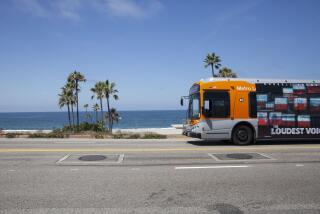THE NEXT LOS ANGELES / TURNING IDEAS INTO ACTION : Getting Around : Are we creating a transit system that makes sense or simply a costly edifice that most Angelenos won’t use? : Success Story : Bus System in Brazil Everything Ours Is Not
- Share via
For a fraction of the cost of installing a subway, officials in Curitiba, Brazil, set up a first-class Jetsons-like bus network--one so convenient and prompt that 75% take mass transit to work.
The bus system in Curitiba, a city of 1.6 million, is everything ours is not: fast, efficient and popular, offering express and short-hop vehicles as well as the ability to readily transfer among different services.
Passengers purchase fares in advance and enter clear cylindrical tube-like stations, where the platforms are the same height as the bus floor. This means riders don’t step up to get on the bus. When the bus arrives, all its doors open. Within seconds, passengers disembark and others board, allowing the bus to zip along to the next stop.
On Los Angeles buses, a significant amount of time is lost at each stop as all passengers enter one door and the driver collects fares. Delays are also caused when passengers, for example parents toting children and strollers, have difficulty mounting the steep steps. In Curitiba, passengers board buses at a rate of eight people per second, or four times faster than people board at conventional bus stops.
The star-shaped city has five major arteries, with large bus terminals at the end of each. Along the arteries, mega-buses travel in exclusive lanes with synchronized traffic lights.
These giant accordion-like buses, the equivalent of three buses connected, can accommodate about 300 passengers as they travel the high-density corridors. The red buses carry about 14,000 passengers an hour, comparable to the capacity of some subways. But their routes cost about $1.3 million per kilometer, or one-eightieth the cost of a subway, by some estimates.
For the convenience of passengers, buses are color-coded. Red buses run along the city’s five main corridors, stopping at every stop. Gray express buses travel parallel to the red ones, outside the bus-only lanes. Yellow feeder buses circulate outside the central city. Green inter-district buses travel concentric routes connecting neighborhoods and main transit centers. Passengers pay one fare (about 40 cents) and can transfer from one service to another.
Unlike those in Los Angeles and other U.S. cities, Curitiba’s transit system is not subsidized. In Los Angeles, taxpayers pay a $21-per-passenger subsidy for every Metrolink rider and $1.17 for each bus ride.
In Curitiba, a government agency orchestrates the running of the system, paying private companies to operate the buses. These companies are paid by the distance they operate. They receive part of the fare, and the rest of the revenue is used to cover such system costs as planning and maintaining roads and terminals.
In fact, the bus system generates revenue for the city. Stores and shops that lease space in stations pay into the city’s coffers.
The city’s three-term former mayor, Jaime Lerner, “believed in the need to create a city where automobiles did not dominate,” said Robert Cervero, professor of city and regional planning at UC Berkeley. At the same time, Lerner wanted an affordable solution for his city’s transportation needs. Deciding against tearing up the city’s 17th-Century buildings to build a subway, he opted for the bus.
The city was designed to be pedestrian- and transit-friendly, hosting high-density housing along the five arteries. Officials also established disincentives for driving: Steep prices are charged for parking, fuel and vehicle registration.
Today, Curitiba “is widely recognized as a medium-sized city which introduced an alternative to the automobile that people are using,” Cervero said. “It’s an example of good planning.”
Residents of Curitiba, the capital of the farming state of Parana, also seem to regard the bus system as a triumph. Seventy-five percent commute by bus in Curitiba, but only 45% do so in Sao Paulo and 57% in Rio. And transportation officials around the world are looking at this city, wondering if its success can be applied elsewhere.
More to Read
Sign up for Essential California
The most important California stories and recommendations in your inbox every morning.
You may occasionally receive promotional content from the Los Angeles Times.













